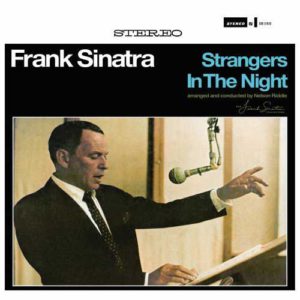The singer would look onto his audience and, with respect to the people who had wrote what he was about to perform, would start naming the songwriters. In the midst of this, he would remark (like one evening in 1988), “I don’t even know who the hell these guys are,” to the laughter of the concert going throng. It was no mistake that he didn’t like the upcoming song personally, but it was also no mistake that its release would return him to the number one spot on the popular music charts. The singer was Frank Sinatra, and the song was a little tune known as “Strangers in the Night.”
Crafted into a memorable orchestration by veteran Ernie Freeman, who would soon arrange Sinatra’s upcoming single and accompanying album “That’s Life,” and written by Burt Kaempfert with English lyrics by Charles Singleton and Eddie Snyder, the song would win three Grammy Awards the year after its May 1966 release, both for “Record of the Year” and “Best Male Vocal Performance for Sinatra, as well as an award to Freeman for best arrangement. In terms of a mainstream audience, it is probably one of the top five songs most associated with the legend of the singer, behind the “Theme From New York, New York,” and “My Way.”
Sensing the instant potential of the song on the album charts, the decision was made to release the burgeoning single as the title track of Sinatra’s upcoming new album, hastily named after the single to assure its mutual chart success. Longtime collaborator Nelson Riddle was handed the reins for this new recording project, the task to create arrangements for an additional nine tracks of music with the same feel and rhythm of Freeman’s orchestration. With a varying musical program of vintage standards and recent pop hits, Riddle would turn in a masterful job, the results yielding some of the finest studio work by Sinatra of the 1960s.
Subtitled “Sinatra Sings For Moderns,” perhaps the most famous song to result from the album besides the title track was that of the song immediately following it in the program, “Summer Wind.” Originally written by German composer Heinz Meier and Hans Bradtke, songwriter Johnny Mercer would, a short time later, take the melody and write a new set of lyrics echoing the sentiments of the German original. Although Sinatra’s recording was not the first by an American artist, it is certainly the most famous. Featured extensively in television and film, it is one of the few Sinatra songs that still receives airplay on mainstream radio stations, often by disc jockeys in rejoice of the summer months. Besides the original recording, a live 1986 version from an Atlantic City concert (taking at a slightly faster tempo) rates a close second as perfection to this author.
Following “Summer Wind,” we are treated to another classic reading, this one harkening back to Sinatra’s days with the Harry James Orchestra, although the arrangement is drastically unlike its soft predecessor, a swingin,’ stompin,’ no holds barred big band arrangement of “All Or Nothing At All.” Riddle mixes electric organ with the traditional big band and the modern instrument is first given center stage on this track, also featured to a high degree on “You’re Driving Me Crazy,” “On A Clear Day,” “My Baby Just Cares For Me,” and “The Most Beautiful Girl In The World.”
Some Sinatra fans say the only downfall in the album is his cover of Petula Clark’s hit song “Downtown,” with the arrangement created by Riddle featuring somewhat of a pseudo-Oriental flavor of instrumentation. Sinatra sounds as though he is having fun, even ribbing the audience near the end by repeating “Downtown” with a cascading vocal that hints he is getting tired of the number. (Some even say his doobie-doobie-doos at the conclusion of “Strangers” is indicative of the same emotions.) Sinatra would later sing “Downtown” as a duet with daughter Nancy when she guested on his television special “A Man And His Music Part II” later that year in 1966. “Downtown” remains another example by Sinatra to break into the ears of a musical public that was rapidly buying up records of other artists in place of his, and regarded somewhat fondly by Sinatra fans today.
The closer, the rapid fire “The Most Beautiful Girl In The World,” has Riddle setting Sinatra in the center of a magic orchestral storm, with the accompanying band pulling out all the stops in a breakneck arrangement to which the singer contributes a strong vocal. The orchestration is so powerful, it was also featured on Sinatra’s “Man And His Music Part II” special, and much later, chosen as one of the many tracks that Frank Sinatra, JR. would record when creating the tribute album “As I Remember It,” some thirty years after its creation. Additionally, Sinatra, JR. would also sing the song often in concert, a lasting tribute not only to his father, but to the arranger who had brought the time-old song back to life, Riddle.
In celebration of its forty-fifth anniversary, Concord Records reissued the album on compact disc, featuring a digitally remastered music program with the addition of three special bonus tracks. First, from his April 1985 concert in Japan, two live performances of “Strangers In The Night” and “All Or Nothing At All,” are included. Second, an alternate version of “Yes Sir, That’s My Baby,” from the original album sessions is also included, with Nelson Riddle heard faintly in the opening seconds counting off the orchestra, with Sinatra coming in briefly at the end telling the men in the recording booth to “play it!”
“Pearce’s Picks” recommends this anniversary version of the album for your immediate consideration. One of Sinatra’s last “traditional” albums before he began showing his attention to much more modern material (Cycles, Watertown) or collaborations with other artists (Antonio Carlos Jobim, Duke Ellington, and Rod McKuen), it serves as a perfect portrait to the Sinatra of the mid-1960s.
For those who aren’t diehard fanatics, it comes highly recommended. 5/5.
Until next time, Sinatra lovers!
Jerry Pearce is an amateur singer in the vein of Frank Sinatra, Perry Como, and Dick Haymes and has released two discs of standards music, Crossroads in 2010, and One Summer Night in 2016. Samples of his music can be heard on his YouTube Channel. To purchase his CDs use the form box below.
[si-contact-form form=’3′]

 September 25th, 2016
September 25th, 2016  CEO
CEO 
 Posted in
Posted in  Tags:
Tags: 



